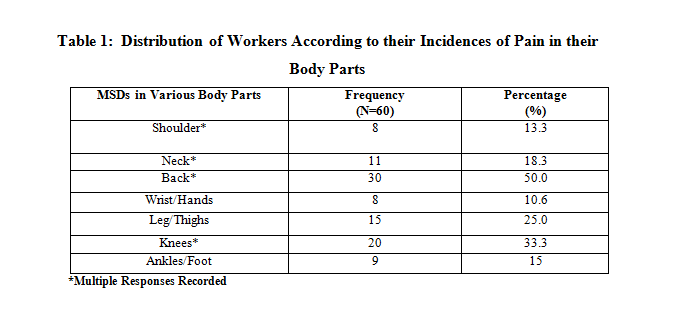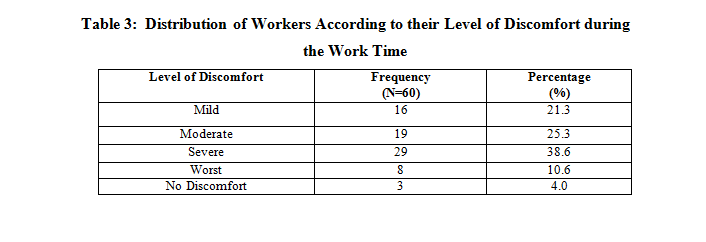Alleviation: An International Journal of Nutrition, Gender & Social Development, ISSN 2348-9340
Volume 5, Number 5 (2018):
© Arya PG College, Panipat & Business Press India Publication, Delhi
www.aryapgcollege.com
Impact of Musculoskeletal Disorders on The Health of Farm Women Engaged in Rice Transplantation
1. Nalini Chandra* & 2 Razia Parvez
1 Post Doctorate Fellow & 2 Associate Professor Department of Family Resource Management and Consumer Science
Ethleind College of Home Science Sam Higginbottom University of Agriculture Technology & Sciences (SHUATS) Allahabad, Uttar Pradesh, India
*Email: nalini_007girl@yahoo.co.in
Introduction
Rural women form the most important productive work force in the economy of majority of the developing nations including India. Women play a vital role in building this economy. Over the years, there is a gradual realization of the key role of women in agricultural development and their vital contribution in the field of agriculture. Rice transplanting is among the most hazardous agricultural tasks. If the activities are continued, ligaments and the bony architect balance the stresses. For a long time, then it becomes MSDs work related factors that present the greatest risk for musculoskeletal disorders (MSDs). Rice transplanting involve fixed and constraint postures, repetitive and forceful hand movements at high pace of work. Such movements strain gradually causing “wear and tear” on the muscles and tendons in the forearms, wrists and affect the back and neck. People who do repetitive work with their bodies in fixed and static positions are even more susceptible to getting work related health problems. Such problems continue to be one of the leading causes of preventable injuries at the workplace. Farmers who are mainly involved in potato cultivation need to stay in squatting position for most of the time in the fields. This type of posturing puts excessive pressure on knee joints. Activities like squatting involve eccentric contraction of quadriceps muscle group. Alain and Delisle (2006) found that obstruction of the blood vessels can result in fatigue and degeneration of the muscles fibers that are recruited at low intensity and over long periods of time. Jyotsna et al (2005) stated that during wheat harvesting activity from morning till evening, women usually adopted squatting posture and they continued to work in this posture for long duration without adopting any other posture due to which they reported severe pain in lower back and knees.
The present study was undertaken to study musculoskeletal disorders in various body regions among farm women engaged in agricultural task.
Methodology
The study was conducted in three villages Asaltpur Farakhnagar, Bhanera Khurd and Fatiyabad Nihaura of Loni Block, Ghaziabad Disrict ( Uttar Pradesh). The sample size comprised of 75 farm women aged between 25-60 years to identify the workers involved in harvesting activity of wheat. Twenty-five farm women from each village were selected for data collection. Purposive sampling technique was adopted to identify the workers who were suffering from MSDs. The body map was used to identify the site of pain whether it is related to joint and muscles. Questionnaire schedule related to MSDs was also prepared.
Results and Discussion

It is visible in the Table 1 that 50 per cent of farm women experienced back pain, followed by 33.3 per cent, 25.0 per cent, 18.3 per cent, 15.0 per cent and 10.6 per cent who experienced knee pain, legs/ thighs pain , neck pain, ankles/foot and wrist/hand pain respectively. It was concluded that these were the symptoms of some musculoskeletal disorders which occur due to repetitive motions and awkward postures adopted while doing agricultural tasks. In farming activity most of the task performed in standing, sitting, squatting and standing cum bending positions. They work in such positions for long hours which cause MSDs.

It is depicted in Table 2 that maximum number of workers experienced pain 3-4 times in a week (30.0 %), 22.0 per cent workers faced problem 1-2 times in a month , 17.0 per cent complained pain once in every day, 13.3 per cent experienced pain several times a day whereas 18.3 per cent constantly felt pain in their body parts.

It is revealed in Table 3 that majority of workers (38.6 %) felt severe discomfort due to pain, 25.3 per cent experienced moderate discomfort due to pain whereas 10.6 per cent faced discomfort due to pain. Only 4.0 per cent of workers did not feel discomfort due to pain in their body parts.
Conclusions
From this study, it has been recommended that workers should avoid bad work postures, should take rest period in between the working hours and avoid long working hours as far as possible during their work for reducing job related health.
References
Alain S and Delisle H (2006) The Impact of Workstation Layout on Postures and Muscles Load of the Upper Limbs. American Journal of Industrial Medicine 17: 449-453.
Gupta G and Tarique (2013) Prevalence of Musculoskeletal Disorders in Farmers of Kanpur-Rural, India. Journal of Community Medicine and Health Education 3: 249.
Jyotsana KR, Singh K and Mehta M (2005) Ergonomic Evaluation of Rural Women While Performing Wheat Harvesting Activity. Journal of Human Ecology 18 (4): 309-311.
NIOSH (2013) Agricultural Safety. Available at https://www.cdc.gov/niosh/agforfish.

